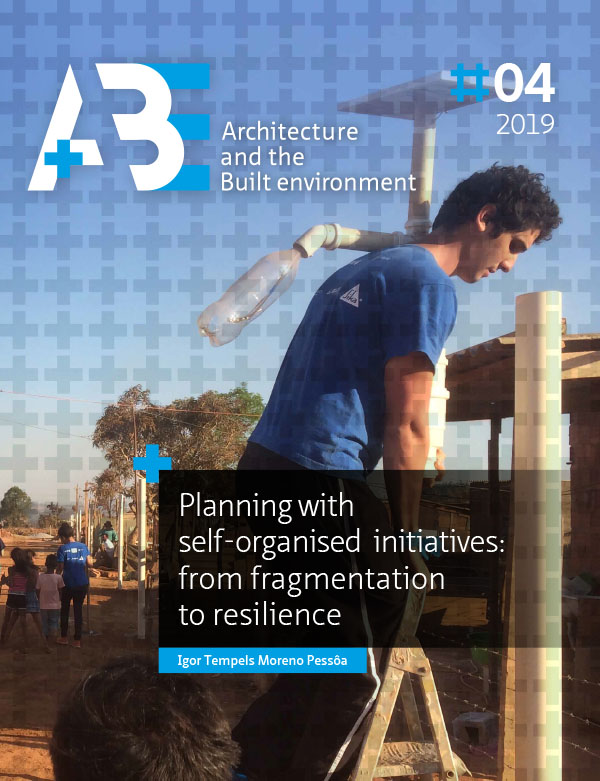Brazilian urban porosity
Treat or threat?
Abstract
Urban areas have spatial discontinuities, such as disconnected neighbourhoods, brownfield areas and leftover places. They can be captured by the metaphor of urban porosity. This article aims to highlight potential social consequences of urban porosity by creating a “porosity index”. We argue that these areas can provide capacity for flexibility, fluidity, and absorption in major cities, but that they can also be a source of fragmentation, disconnection, and isolation between different social groups, eroding the adaptive capacity of metropolitan systems. Porosity may thus have both positive and negative influences on the resilience of urban systems. Brazil’s rapid process of urbanisation over the last 50 years shows both these sides of porosity, which create treats and threats for its urban systems. This paper develops an analytical framework within which to study how porosity manifests itself in Brazilian metropolises, which helps to identify porosity in contexts of urban growth and decline. It uses statistical data from IBGE relating to 12 Brazilian metropolises to generate the proposed porosity index. Additionally, the paper discusses the added value of the concept of urban porosity in addressing urban resilience and briefly elucidates the issues and opportunities caused by discontinuities in the urban fabric in Brazil’s metropolises.
References
Adolphe, L. (2001). A simplified model of urban morphology: application to an analysis of the environmental performance of cities. Environment and Planning B: Planning and Design, 28, 183-200. doi:10.1068/ b2631
Balbo, M. (1993). Urban Planning and the fragmented city of developing countries. Third World Planning Review, 15, 23-35.
Balbo, M., & Navez-Bouchanine, F. (1995). Urban Fragmentation as a Research Hypothesis: Rabat-Salé Case Study. Habitat International, 19(4), 571-582.
Benjamin, W. (1978). One-Way Street and Other Writings. Thetford, UK: Lowe & Brydine.
Bowman, A. O. M., & Pagano, M. A. (2004). Terra incognita : vacant land and urban strategies. Washington, D.C.: Georgetown University Press.
Coy, M. (2006). Gated Communities and Urban Fragmentation in Latin America: the Brazilian experience. GeoJournal, 66, 121-132.
Dixon, T., Otsuka, N., & Abe, H. (2011). Critical success factors in urban brownfield regeneration: an analysis of ‘hardcore’ sites in Manchester and Osaka during the economic recession (2009-10). Environment and Planning A, 43(4), 961-980. doi:Doi 10.1068/A43468
Eraydin, A. (2010). Resilient thinking in urban planning and practice. Paper presented at the 24th AESOP, Finland.
Fleischhauer, M. (2008). The role of spatial planning in strengthening urban resilience. In H. J. Pasman & I. A. Kirillov (Eds.), Resilience of cities to terrorist and other threats. Learning from 9/11 and further research issues (pp. 273-298). Dordrecht: Springer.
Godschalk, D. R. (2003). Urban hazard mitigation: Creating resilient cities. Natural Hazard Review, 4(3), 136- 143.
IBGE. (2008). Regiões de Influência das Cidades (ISBN 978-85-240-4038-2). Retrieved from Rio de Janeiro, Brazil: ftp://geoftp.ibge.gov.br/regioes_de_influencia_das_cidades/regic.zip
IBGE. (2015a). População presente e residente. Retrieved from http://seriesestatisticas.ibge.gov.br/series. aspx?no=10&op=0&vcodigo=CD90&t=populacao-presente-residente
IBGE. (2015b). Taxa de Urbanização. Retrieved from http://seriesestatisticas.ibge.gov.br/series.aspx?no=10&op=0&vcodigo=POP122&t=taxa-urbanizacao
Jaramillo, S. (1999). El papel del mercado del suelo en la configuración de algunos rasgos socioespaciales de las ciudades latinoamericanas. Territorios, 2, 107-109.
Ludwig, D., Walker, B. H., & Holling, C. S. (1997). Sustainability, stability, and resilience. Conservation ecology, 1(1).
Pessoa, I. M., Taşan-Kok, T., & Altes, W. K. (2016). Brazilian urban porosity: treat or threat? Proceedings of the Institution of Civil Engineers - Urban Design and Planning, 169(2), 47-55. doi:doi:10.1680/udap.15.00009
Secchi, B. (2007). Rethinking and Redisigning the Urban Landscape. Places, 19(1).
Stavrides, S. (2007). Heteropias and the Experience of Porous Urban Space. In K. A. Franck & Q. Stevens (Eds.), Loose Space: Possibility and Diversity in Urban Life. Abingdon: Routledge.
Taşan-Kok, T., & Stead, D. (2013). Analysing the Socio-Spatial Vulnerability to Drivers of Globalisation in Lisbon, Oporto, Istanbul, Stockholm and Rotterdam. In T.
Taşan-Kok & A. Eraydin (Eds.), Resilience Thinking in Urban Planning (pp. 71-92). Dordrecht: Springer.
Taşan-Kok, T., Stead, D., & Lu, P. (2013). Conceptual Overview of Resilience: History and Context. In A. Eraydin & T. Taşan-Kok (Eds.), Resilience Thinking in Urban Planning (pp. 39-52). Dordrecht: Springer.
Viganò, P. (2013). Urbanism and Ecological Rationality. In S. T. A. Pickett, M. L. Cadenasso, & B. McGrath (Eds.), Resilience in Ecology and Urban Desing: Linking Theory and Practice for Sustainable Cities (Vol. 3, pp. 407-426). Dordrecht: Springer.
Walker, B., Holling, C. S., Carpenter, S. R., & Kinzig, A. P. (2004). Resilience, adaptability and transformability in social-ecological systems. Ecology and Society, 9(2).
Walker, B., & Salt, D. (2006). Resilience thinking: Sustaining ecosystems and people in a changing world. Washington, DC: Island Press.
Wardekker, J. A., Jong, A. d., Knoop, J. M., & Sluijs, J. P. v. d. (2010). Operationalising the resilience approach to adapting an urban delta to uncertain climate changes. Technological Forecasting and Social Change, 77(7), 978-998.

